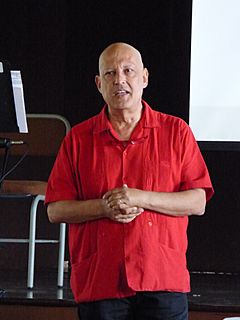Javier Álvarez (composer) facts for kids
Quick facts for kids
Javier Álvarez
|
|
|---|---|

Álvarez in 2002
|
|
| Born |
Javier Álvarez Fuentes
8 May 1956 Mexico City, Mexico
|
| Died | 23 May 2023 (aged 67) Mérida, Yucatán, Mexico
|
| Education |
|
| Occupation |
|
| Organization |
|
| Awards |
|
Javier Álvarez Fuentes (born May 8, 1956 – died May 23, 2023) was a famous Mexican composer. He was known for mixing different musical styles and traditions from all over the world in his songs. He often used cool and unusual instruments, along with new music technology. Many of his works brought together modern tech with instruments and sounds from various cultures. He also taught music in different countries, like the UK and Sweden, and later returned to Mexico to teach.
Early Life and Music School
Javier Álvarez was born in Mexico City on May 8, 1956. His father, Augusto H. Álvarez, was an architect. Javier went to different schools, including the Escuela Moderna Americana and the Lycée Franco-Mexicain.
When he was 18, he started studying at the National Conservatory of Music (Mexico). There, he learned to play the clarinet and studied how to compose music. Later, he moved to the University of Wisconsin–Milwaukee in the United States, where he earned a master's degree in music theory and composition in 1981.
Javier then went to London, England, to continue his studies at the Royal College of Music and the City, University of London. During his time as a student in London, he started creating his first electroacoustic music. This is music that uses electronic sounds and technology. One of his early pieces was Temazcal in 1984.
A Career in Music and Teaching
Javier Álvarez's music often included sounds and rhythms from Latin American dance styles, like mambo. His pieces were played by famous orchestras around the world, such as the Chicago Symphony Orchestra and the Los Angeles Philharmonic.
He even composed the music for a horror film called Cronos in 1993, directed by Guillermo del Toro.
From 1993 to 1999, Javier was a special Fellow for Mexico's National Endowment for the Arts and Culture. He also helped start the Sonic Arts Network and was the artistic director for the Society for the Promotion of New Music in 1993.
Javier was a professor at several music schools, teaching how to compose and use computer music. These schools included City University London, the Guildhall School of Music and Drama, and the Royal College of Music.
After living in England for 25 years, Javier returned to Mexico. He became the Dean of the Conservatorio de Las Rosas in Morelia. In 2004, he helped create the musical arts department at the Escuela Superior de Artes de Yucatán, and he was its director starting in 2018. He lived in Mérida, Yucatán, where he continued to compose music and lead projects.
Famous Compositions
Javier Álvarez's first electroacoustic music piece, Temazcal (1984), was created when he was a student. In this well-known piece, he used maracas (shakers) with complex electronic sounds.
His piece Mannam (1992) was inspired by an old Korean instrument called a kayagum, which is like a zither. This piece won an award called the Prix Ars Electronica. It mixed Korean music with sounds and playing styles from the Mexican folk harp. Another work, Offrande (2001), combined Caribbean steelpan drums with electronic rhythms.
Javier also loved to use Latin American dance music, especially mambo, in his works. In Mambo a la Braque (1991), he made an electronic mix using parts of songs by the Cuban mambo composer Pérez Prado.
Some of his other notable works include:
- Solo and Chamber Music: Pieces for one instrument or a small group, like Ki Bone Gaku (1984) for trombone and marimba, or Metro Chabacano (1991) for string quartet.
- Orchestra Music: Larger pieces for a full orchestra, such as Trireme (1983) for French horn and orchestra.
- Voice and Instruments: Songs that combine singing with instruments, like Canciones de la Venta (1977).
- Electroacoustic Music: Many pieces that use electronic sounds, like Papalotl (1987) for piano and electronic sounds, or Shekere (2001) using a shekere gourd.
Recordings and Awards
Javier Álvarez's music has been recorded and enjoyed by many. His chamber music piece Temazcal was recorded in 2003. Another piece, Metro Chabacano, was recorded in 2012 and described as a "hypnotic" and continuous piece of music.
He received many awards for his amazing work. These include the Mendelssohn Scholarship in 1986 and the Prix Ars Electronica multiple times, including for Mannam in 1993. In Mexico, he was honored with the Medalla Mozart, the Premio Nacional de Ciencias y Artes in 2013, and the INBA's Medalla Bellas Artes in 2015. In 2014, he became a member of the Academia de Artes.
Personal Life and Passing
Javier Álvarez was married to Daniela, and they had a son and a daughter.
He passed away in Mérida on May 23, 2023, at the age of 67. Alejandra Frausto, Mexico's Secretary of Culture, said that he was a "musician and composer who never stopped creating, suggesting new ideas, and working for his community and for his beloved Mérida."
Images for kids
See also
 In Spanish: Javier Álvarez Fuentes para niños
In Spanish: Javier Álvarez Fuentes para niños




